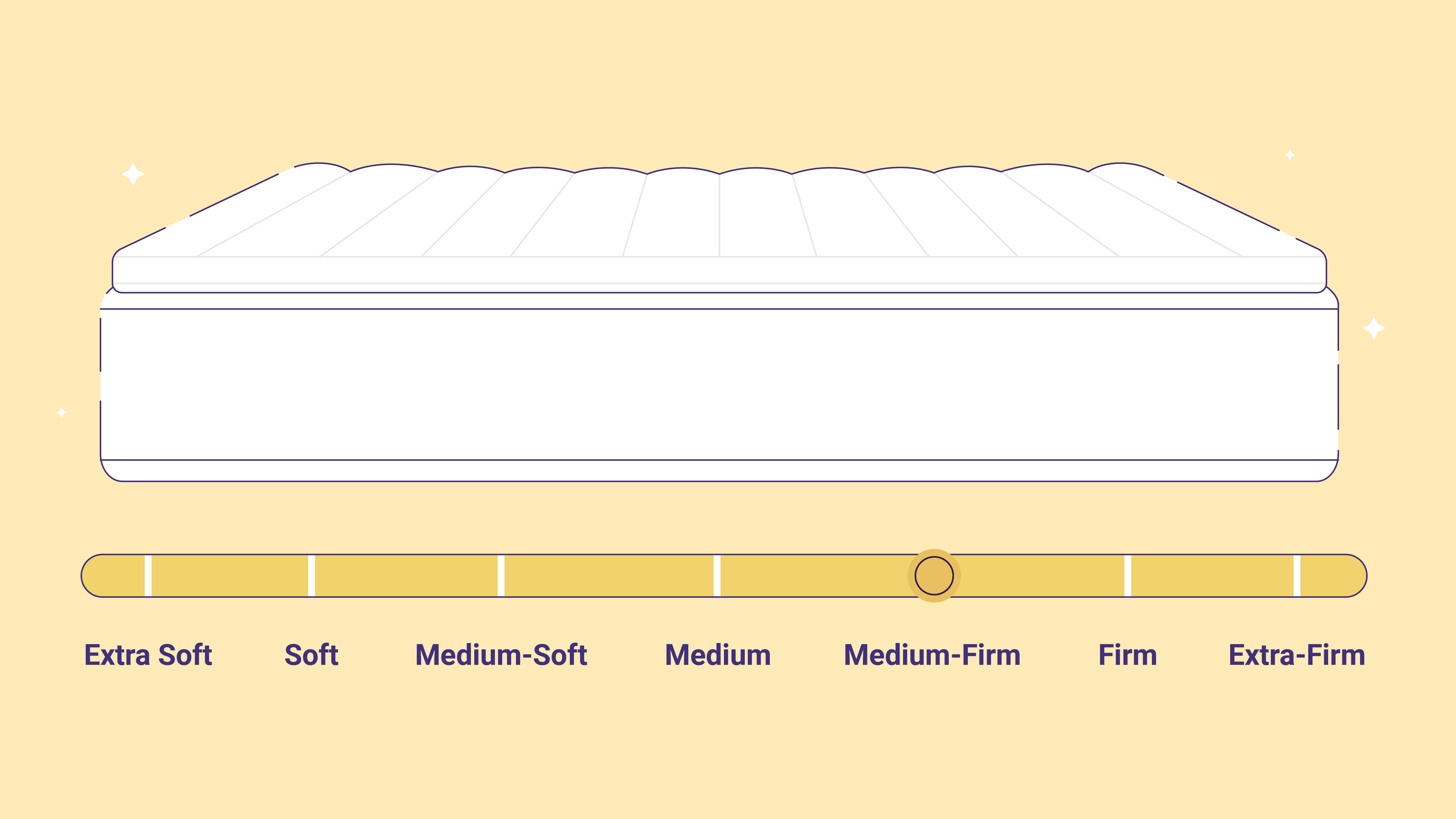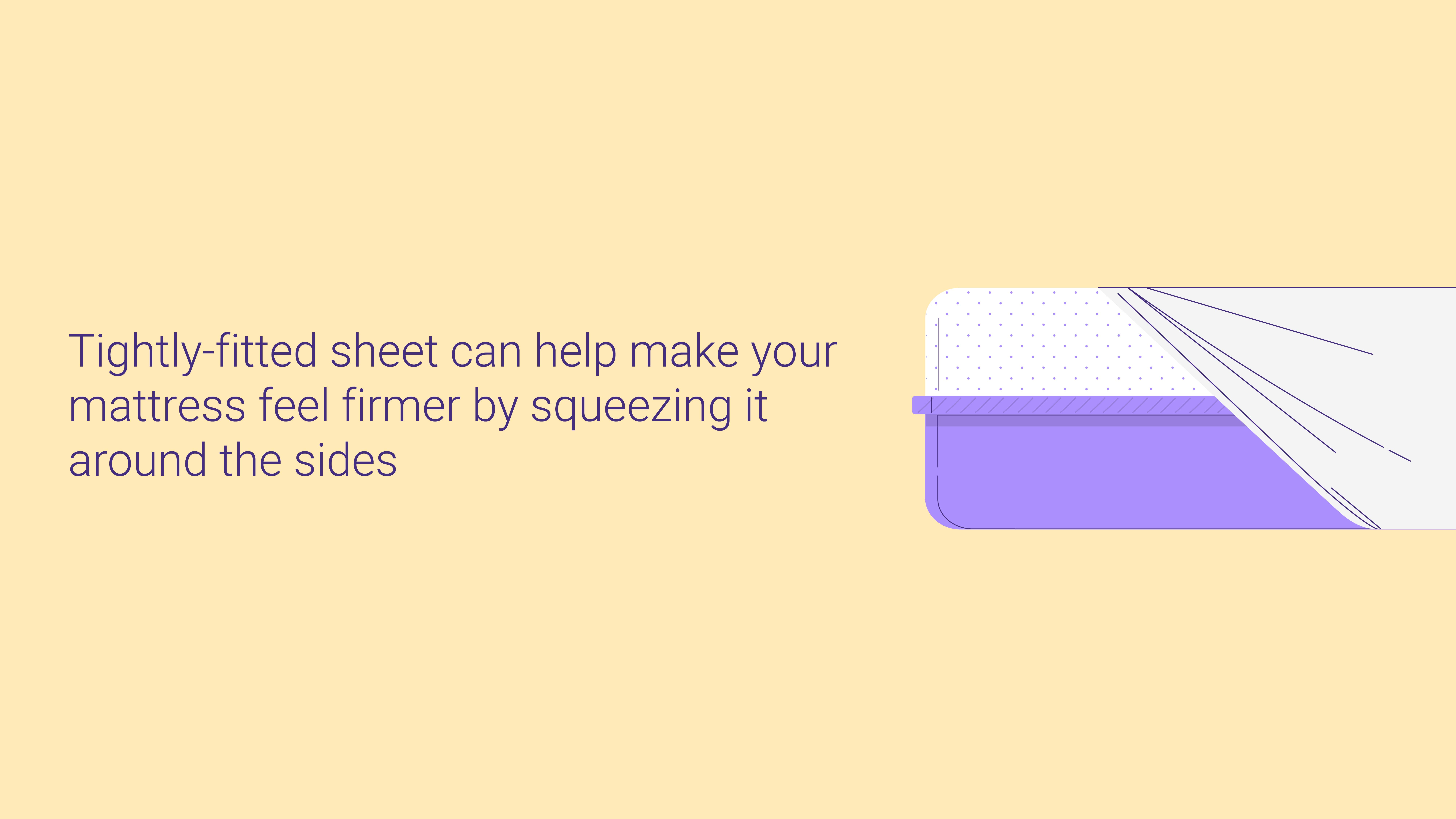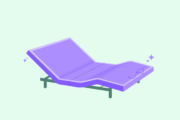
How to Make a Mattress Firmer

- Opt for a mattress foundation or platform bed over box springs to provide better support and prevent sagging over time.
- Choose memory foam or latex toppers with zoned support technology to enhance spinal alignment and provide extra firmness where needed.
- Regularly rotate and flip your mattress, use tightly-fitted sheets, and consider professional cleaning to maintain the firmness and overall condition of your mattress over time.
There are lots of reasons why your current mattress might not be as firm as you want it:
- Maybe you got it a few years ago, and your preferences or sleeping positions changed since then.
- Maybe the mattress is a hand-me-down purchased by someone else.
- Maybe you entered into a relationship, and your mattress just doesn’t offer sufficient support for two people.
- Maybe your mattress is getting older and saggier, but you’re not ready to break the bank on a new one just yet.
Thankfully, there are a few effective solutions to help you increase the firmness of your bed without wasting an otherwise good mattress (and shelling out thousands of dollars for a new one). Below, we’ll explore a few simple tips and sleep products to add firmness to an existing mattress.
Lose the Box Springs
Box springs are wooden frames that surround a layer of metal coils. The box is covered by an anti-skid cloth on the top and a breathable dust barrier on the bottom. Box springs are one of the worst bases to put your mattress on because they start to lose their tension over time. This can lead to your mattress sagging or collapsing in the middle since there’s not much support underneath it.
Spring for a mattress foundation or platform bed instead of box springs. These bases offer a much more rigid structure for every type of mattress, whether it’s a memory foam or latex foam, or innerspring. The rigidity helps evenly distribute support across the entirety of your mattress, which can prevent sagging in the middle and make the whole thing feel firmer.
A mattress foundation is usually a wooden frame with slats crossing the width of the frame at close intervals (2 to 2.75 inches apart) to provide support to the weight of the mattress and sleeper(s). Platforms are similarly constructed either of wood or metal, but the main difference between them is platform beds are made to stand on their own, while foundations are made to go in a bed frame. Foundations are also usually covered in a breathable fabric while platforms normally aren’t.
Add a Firm Mattress Topper
A lot of people think of mattress toppers as a way to make an overly firm mattress softer, but they’re also a great way to do the opposite. Memory foam or natural latex toppers come in a range of firmnesses and comfort levels.
Memory foam mattress toppers with zoned technology usually make for the most comfortable and longest lasting toppers. Zoned support technology facilitates healthy spinal alignment by offering dynamic full-body support—cradling pressure points at the shoulders and hips while giving extra firmness in areas that need it, such as the torso, head, and feet.
If you’re looking for firm mattress toppers, we suggest avoiding more pillowy materials like wool, fiberfill, and down. Stick with high-density foam toppers.
Replace Your Bed Frame Slats
Many bed frames come with wooden slats meant to support the box springs or mattress foundation. Over time, the wood can start to sag. Replacing the old slats with new slats can help shore up support underneath your bed base (especially if it’s a box spring) and increase support for your mattress.
Rotate or Flip the Mattress
Like everything else on Earth, mattresses will eventually fall victim to gravity. Additionally, your body weight puts pressure on the same part of the bed every night, which can lead to sagging and overly compressed areas of the bed.
Flipping and rotating your mattress can solve these problems. Flipping the mattress allows gravity to pull its internal materials the opposite way, helping to correct sagging. Rotating the mattress lets you put the heavier parts of your body on different areas of the bed, preventing sagging in specific spots, kind of like rotating your tires.
A lot of mattresses on the market nowadays aren’t flippable since they’re built with specific layer constructions. Memory foam, latex, and hybrid mattresses—unless designed with flippable firmness—should only be rotated. Innerspring mattresses are really the only mattress types that can be flipped anymore. But even if your mattress can’t be turned over, rotating it 180 degrees every couple of months can even out wear and tear and increase firmness.
Use Tight Fitted Sheets
A tightly-fitted sheet can help make your mattress feel firmer by squeezing it around the sides, helping to prevent the mattress’s comfort layer from overly compressing when you lie down on the bed.
Since fitted sheets lose their tautness over time, too, you’ll have to replace your fitted sheet every now and again to keep it compressing on your mattress. The compression provided by your fitted sheet also may not make much of a difference in firmness, depending on your mattress’s age, condition, and material. If you want a little more firmness, the fitted sheet should work just fine. If you want a lot more firmness, you may need to go for a different option like a new base or topper.

Change Your Mattress Layers
A lot of mattresses come with multiple layers, and when certain layers become damaged or worn out, it can reduce the firmness of your mattress. Replacing these can be easier said than done, since many manufacturers don’t make their mattresses with easily swappable layers or removable covers.
However, this may be a service your manufacturer provides under the terms of the warranty. Give them a call or check your warranty to see if you can get repair or replacement services.
Place the Mattress on the Floor
If your bed base has too much give and you don’t want to buy another one, you could try placing your mattress straight onto the floor to eliminate all give underneath it. Using a floor mattress is the cheapest option, as it doesn’t require any additional purchase on your part.
However, you should consider the disadvantages of putting a mattress directly on the floor. Reduced airflow underneath your mattress can cause it to retain both heat and moisture, leading to a hotter night’s sleep and making it more likely to break down faster. Since it’s directly on the floor, your mattress is more vulnerable to any pests crawling around down there—like dust mites, carpet beetles, and roaches.
Have Your Mattress Cleaned
When your bed absorbs moisture, the dampness makes it feel softer. This is more common in humid areas, but it can be an issue anywhere—especially if you sweat a lot while you sleep. Professional cleaning and drying can help remove built-up sweat and humidity inside your mattress.
Another option is taking the mattress outside and laying it in the sun. A day under the blazing sun will help evaporate moisture. Just make sure you’re laying your mattress on top of a tarp or clean plywood to prevent it from making contact with the ground.
Put Plywood Boards Under Your Mattress
Bunkie boards are a great option for increasing the firmness of your mattress. These are normally just a single sheet of plywood or composite board made to fit whatever sized mattress you have. You slide the bunkie board between your mattress and its base, and it will increase the apparent firmness of your mattress.
Be aware of what kind of mattress you have if you’re planning to use bunkie boards. Some mattresses, especially foam mattresses, might grow mold if they’re not on a breathable base. See your manufacturer’s recommendations about base breathability if you’re thinking about adding plywood support.
FAQs
Will my warranty cover sagging/loss of firmness?
Almost all warranties cover structural defects and manufacturer errors, and most manufacturers will either repair or replace mattresses with these issues. However, it isn’t standard for warranties to cover a normal increase in the softness of the mattress material over time.
Warranties also don’t typically cover normal wear and tear or accidental damage to your mattress. If your sagging is due to faulty craftsmanship, you can probably call in your warranty. However, if your mattress just softened over time, it’s doubtful your warranty will cover this issue. It never hurts to check with your manufacturer, but temper your expectations if you know your mattress is just another victim of time passage and normal use.
Are metal bed frames better than wood?
This isn’t a straightforward answer. There are a few advantages to metal bed frames that make them a great alternative to wood frames, but they have a few disadvantages as well.
As far as advantages go, metal bed frames are usually a lot harder to damage than wooden frames—they’re less vulnerable to water, bed bugs, and decay. They also tend to be cheaper than wood frames. Metal frames can be much lighter and more mobile than wooden frames, and they’re usually easier to set up too.
However, metal frames have some drawbacks. For one thing, they’re a lot noisier than their wooden counterparts, and they can creak and squeak as you move around in them. They also aren’t normally as aesthetically pleasing as wooden beds, which can have a huge range of design elements, including storage capacity. Metal frames often don’t include as much support as wooden frames because wooden frames tend to come with more slats than metal ones.
How much should I pay for a mattress topper?
Mattress toppers shouldn’t be 50 bucks. If they are, you can bet you’re not getting a quality product. By the same token, if you’re paying almost as much for the topper as you’d pay for the mattress, you’re probably getting ripped off. Generally, a good mattress topper should range from $150 to $400, depending on the size of your bed.
What kinds of materials go in a mattress pad?
Material is a big factor in the quality of your mattress toppers. Cotton, latex, and wool are all common materials for bed toppers. Cotton tends to be much thinner than other materials and doesn’t provide much support. Wool pads can get super hot at night—a real nightmare if you’re already a hot sleeper.
Memory foam is usually the best material for a mattress topper. Memory foam toppers are ultra-contouring and pain-relieving, they offer a lot of support, and they also allow for more versatility because their comfort levels can be altered to increase softness or firmness.
Do all mattresses lose firmness over time?
Short answer: yes. During the break-in period, you will notice your mattress getting a little softer. Normally, this will happen within the first 50 or 60 nights of use, which is why it’s so important to make sure your mattress comes with an adequate trial period before you buy it. Your trial period should be no fewer than 90 days so you can be sure you’ve got the right mattress.
After the break-in period, mattresses will slowly continue to soften over time, though some mattresses last longer than others. The natural compression of your body will stretch your bed over time, leading it to eventually lose its firmness and start to sag. Foam mattresses begin to lose their firmness over the years, and innerspring mattresses will sag as coil tension decreases. This is just part of your bed’s natural lifespan, and it should be close to a decade before you have to worry about replacing your new mattress, especially if you take good care of it.
Bottom Line
When it comes to mattresses, there’s bad news, good news, and great news. The bad news about mattresses is they all lose their firmness over the course of their lifetimes, eventually necessitating their replacement.
The good news is you can slow down the softening process by taking care of your mattress. Rotating it often, keeping it clean, avoiding letting kids play or jump on it, using a mattress protector, and keeping it properly supported are all good ways to make sure your bed lasts as long as possible.
The great news is if you want to shore up the firmness of your bed, there’s plenty you can do short of springing for a new one. Tons of products from bunkie boards to toppers can help your mattress feel firmer, lengthening its lifespan and saving both your wallet and your night’s sleep.



